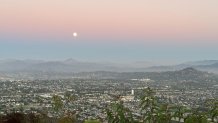San Diego star-gazers, get ready for a rare astronomical event!
A full moon, supermoon and blue moon will all converge together into the bright nighttime sky on Wednesday, Aug. 30.
This natural phenomenon won't happen again for 14 years, so mark your astronomy calendars.
What time is the super blue moon 2023 in San Diego?
Get top local stories in San Diego delivered to you every morning. Sign up for NBC San Diego's News Headlines newsletter.
The moon will rise Wednesday evening at 7:29 p.m., reach its highest point in the sky at 12:14 a.m. (with a whopping 99% illumination), and will set at 5:44 a.m., according to the Farmers' Almanac.
“Warm summer nights are the ideal time to watch the full moon rise in the eastern sky within minutes of sunset. And it happens twice in August,” retired NASA astrophysicist Fred Espenak told the Associated Press. Espenak is dubbed Mr. Eclipse for his eclipse-chasing expertise.

What is a blue moon?
As with the monikers of many astronomical phenomena, the moon will not actually look blue. A "blue moon" is the term for the second full moon in a month, which usually only has a single full moon.
What is a supermoon?
The moon is constantly moving in an oval shape around the Earth. So sometimes it's closer to the Earth and sometimes it's farther away, according to NASA.
A supermoon occurs when the moon is full while at the same time reaching at or near its closest point to Earth, specifically within 90% of the closest it can be to our planet, NASA says.
The full moon will be closer to us earthlings than usual, making it appear brighter and more "super" than a regular full moon.
How to see the super blue moon of 2023 in San Diego
If skies are clear, binoculars and backyard telescopes may enhance your viewing, according to Espenak, revealing lunar maria, which are the dark plains formed by ancient volcanic lava flows, plus rays which radiate from lunar craters.
The very bright moon shouldn't be hard to find, but if you want to view this moon without waiting for it to reach its meridian, head to higher ground.
Current top stories on NBC 7 San Diego
A rare trifecta of natural phenomena
You'll have to wait until January and March 2037 for the next super blue moons, which will occur just after each other!
The last time two full supermoons happened during the same month was in 2018.
About 25% of all full moons are supermoons, but only about 3% of full moons are blue moons, NASA says. The time in between super blue moons is rather irregular, with 10 years the average and 20 years the maximum.
August's full moon is traditionally known as the sturgeon moon, according to the Old Farmers' Almanac. Hundreds of years ago, the full moon would illuminate the once-abundant sturgeon fish species in the Great Lakes during August.
Recent supermoon encounters
You might remember the year's first supermoon happened in July. The fourth and last time to catch a supermoon this year will be in September, AP says. However, this August supermoon will be closer to us than those, so you won't want to miss this luminous event.
If you're mesmerized by the moon, NASA has a daily moon guide here, which is an interactive map for observing the moon each day of the year.



